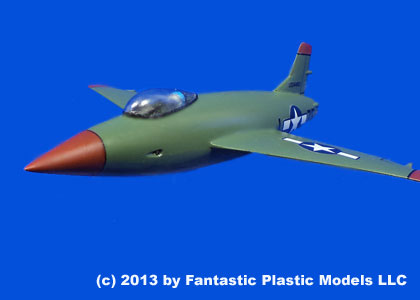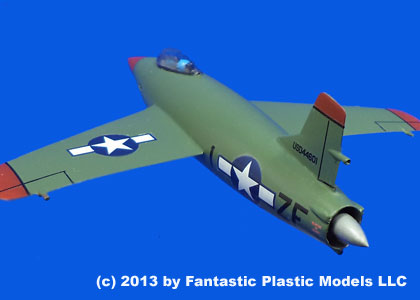Boeing Commercial Space Taxi and Atlas V Launcher Move Closer to Blastoff
Boeing’s 7-man capsule is getting somewhat closer to flying. Wind tunnel testing has been done with the Atlas V booster. First manned flight planned for 2016.
Boeing’s 7-man capsule is getting somewhat closer to flying. Wind tunnel testing has been done with the Atlas V booster. First manned flight planned for 2016.
Alex Tremulis was an industrial designer. Best known for designing the Tucker automobile, he spent WWII in the Army Air Corps at Wright Field designing advanced combat aircraft. One of the most interesting designs he produced was known as the “Zero Fighter,” a rocket powered interceptor which had a large booster rocket first stage.
I mastered parts for a kit of the Zero Fighter for Fantastic Plastic. FP has just released the 1/48 kit. I understand that this is a limited run kit, so get yours soon…



The concept of an orbital fuel depot, supplied from Earth in order to fuel missions to Mars and the like, is not especially new. Shown below is a concept from General Dyanamics from 1963, depicting a toroidal propellant depot. A torus is a rather poor shape for such a thing… not only is it heavier than an equivalent-mass spherical tank, it also has substantially more surface area. But the advantage of this configuration is that it would easily pack in excess payload space aboard a partially-loaded Nova launch vehicle. Dimensions weren’t given, but maximum diameter would be less than 70 feet.
A few years back I received in trade a number of diazo “blueprints” (white paper, blue lines). tucked in among ’em were a number of SST diagrams, including two very large & detailed Boeing 2707 layouts… the original 2707 (swing wing) and 2707-200 (swing wing & canard). These were about 3 feet by 8… very big. And as with virtually all blueprints that were actually made to be used, they were folded, not rolled. Having been folded for 40+ years meant that they were a scanning nightmare… the paper was very stiff, and had it been fed through a large format scanner it would have produced dismal results. The best way to deal with such prints is to unfold them an either compress them (impossible give the size) or roll them up, and leave them to st for several months. I rolled them up. And forget them for several *years.* Just found ’em again. They are fragile, but have “relaxed” from being folded, and are now happily cylindrical.
I think they’d make dandy cyanotypes. They would have to be smaller than the originals, however… 2 feet by 5. Anyone interested? They’d be pretty pricy, on the order of $80-$100. But you’d be the only kid on your block with one…
In the early 1960’s, NASA wanted the Nova rocket: a launch system capable of orbiting around one million pounds. The primary missions included manned lunar and Mars missions, space station launches, that sort of thing. But other missions were contemplated, including military missions. Information on these military missions is pretty lean. This is most likely due to the fact that Nova was a NASA project with minimal DoD input… thus there would have been minimal actual work done on military launch planning for Nova. Nevertheless, a few snippets of military Nova data have come to light from time to time.
A General Dynamics/Astronautics presentation to NASA in August 1963 had a few paragraphs and a few charts discussing military missions. Sadly there was little more; it is impossible to determine if these concepts were actually requested by NASA or not, and whether these ideas went any further. BAMBI (BAllistic Missile Boost Intercept), an anti-missile satellite system, was studied by General Dynamics at the same time as Nova, and has largely remained classified (or at least, little has been made public). Like the anti-missile satellites studied during the SDI program of the 1980’s, for BAMBI to have had a chance of success at taking out a massed Soviet ICBM strike, a large number of the satellites would be needed. In the NOVA presentation, 14 million pounds worth of satellites – each weighing 4,000 pounds – were claimed as needed. In this case, launching 3,500 or so satellites would be a chore that Nova could handle easier than much smaller launch vehicles.
More unconventionally, Nova was also proposed as a logistics transport. In this case, it could be used to chuck a capsule across the planet sub-orbitally… a capsule with 2.5 million pounds of payload. Additionally, Nova could put a 1 million pound capsule into orbit; the capsule would de-orbit itself and land to disgorge infantry. Orbital systems were in a way prefered, as orbital systems meant that the Nova itself would go into orbit. This meant that the Nova could de-orbit on command an return to Earth at convenient locations for recovery; ballistic lobs would essentially throw the Nova away. The orbital capsule was at least illustrated with a drawing.
Finally, Nova could be used to launch offensive weapons. One million pounds were the weights given, so presumably these were meant to go into orbit. The weapons loads were remarkable, and more than a little spooky:
Note… these weapons loads are for a single launch.
Not provide in the presentation – or anywhere else that I’ve seen – is NASAs reaction to the idea of using their rocket to launch a million square miles worth of biological horror.
An illustration of Grumman’s 619 Space Shuttle – the final competitor for the competition that North American Rockwell won – lifting off. This design from 1972 was laid out pretty much as the final Space Transportation System was, but with some notable differences:
1) Stabilizing fins on the external tank
2) A “humped” back
3) four turbojet engines could be stored in the rear of the cargo bay, used for landing range extension, go-around capability and self-ferrying
4) Smaller OMS pods
5) Separate reaction control pods on the wingtips
One pre-Shuttle idea for a space logistics vehicle was the “Big Gemini.” This would have used portions of the Gemini re-entry capsule as the nucleus around which a much large conical capsule would be built. The adapter section would be done away with and replaced with a conical section (with a geometry matching and extending the Gemini capsules) to house a variable number of passengers. A large number of “Big G” configurations were put forward; generally these were to be launched atop the Saturn Ib, but Saturn V and Titan IIIc options were also studied.